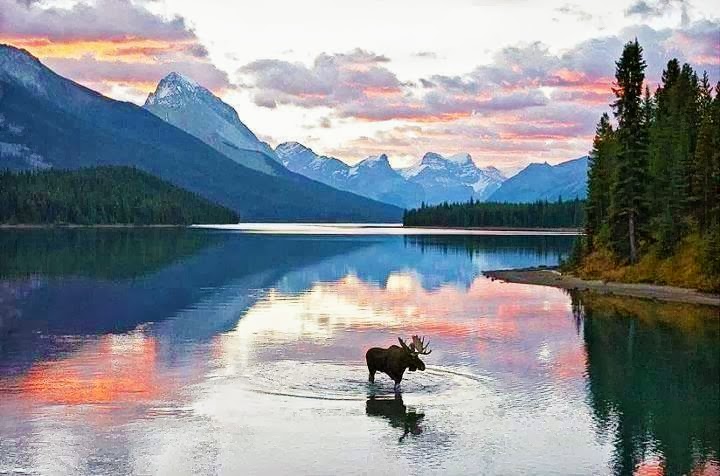


Iguazu Falls, Iguassu Falls, or Iguaçu Falls (Portuguese: Cataratas do Iguaçu, (Portuguese pronunciation: [kataˈɾatɐz du iɡwaˈsu]; Spanish: Cataratas del Iguazú, Spanish pronunciation: [kataˈɾatas del iɣwaˈsu]) are waterfalls of the Iguazu River located on the border of the Brazilian state of Paraná and the Argentine province of Misiones. The falls divide the river into the upper and lower Iguazu.
Their name comes from the Guarani or Tupi words y (IPA:[ɨ]) (water) and ûasú (IPA:[wa'su]) (big).[1] Legend has it that a god planned to marry a beautiful aborigine named Naipí, who fled with her mortal lover Tarobá in a canoe. In rage, the god sliced the river creating the waterfalls, condemning the lovers to an eternal fall.[2] The first European to find the falls was the Spanish Conquistador Álvar Núñez Cabeza de Vaca in 1541, after whom one of the falls in the Argentine side is named.[1] The falls were rediscovered by Boselli[2] at the end of the nineteenth century, and one of the Argentine falls is named after him.
Iguazu Falls was short-listed as a candidate to be one of the New7Wonders of Nature by the New Seven Wonders of the World Foundation. As of February 2009 it was ranking fifth in Group F, the category for lake, rivers, and waterfalls.[3]
Comparisons to other famous falls
The Iguazu Falls are situated on the border of Argentina and Brazil, who both claim the falls as one of their top tourist destinations. In peak flow the water has a massive surface area of 1.3 million square feet, split over about 270 separate falls.
Iguazu Falls are wider in area than the Niagara or Victoria falls and despite being reportedly more spectacular than both have failed to achieve as much fame.
Upon seeing Iguazu, the United States' First Lady Eleanor Roosevelt reportedly exclaimed "Poor Niagara!"[1] Iguazu is also often compared with Southern Africa's Victoria Falls which separates Zambia and Zimbabwe. Whilst Iguazu is wider because it is split into about 270 discrete falls and large islands, Victoria is the largest curtain of water in the world, at over 1,600 m (5,249 ft) wide and over 100 m (328 ft) in height (in low flow Victoria is split into five by islands; in high flow it can be uninterrupted). The only wider falls are extremely large rapid-like falls such as the Boyoma Falls). With the flooding of the Guaíra Falls in 1982, Iguazu currently has the greatest average annual flow of any waterfall in the world.
The water falling over Iguazu in peak flow has a surface area of about 40 Ha (1.3 million ft²) whilst Victoria in peak flow has a surface area of over 55 ha (1.8 million ft²).[5] By comparison, Niagara has a surface area of under 18.3 ha (600,000 ft²).[6] Victoria's annual peak flow is also greater than Iguazu's annual peak—9,100 m³/s versus 6,500—though in times of extreme flood the two have recorded very similar maximum water discharge (well in excess of 12,000 m³/s). Niagara's annual peak flow is about 2,800 m³/s, although an all-time peak of 6,800 has been recorded.[6] Iguazu and Victoria fluctuate more greatly in their flow rate. Mist rises between 30 metres (98 ft) and 150 m (492 ft) from Iguazu's Devil's Throat, and over 300 m (984 ft) above Victoria.
Iguazu, however, affords better views and walkways and its shape allows for spectacular vistas. At one point a person can stand and be surrounded by 260 degrees of waterfalls. The Devil's Throat has water pouring into it from three sides. Likewise, because Iguazu is split into many relatively small falls, one can view these a portion at a time. Victoria does not allow this, as it is essentially one waterfall that falls into a canyon and is too immense to appreciate at once (except from the air).
HOW DO THEY COMPARE TO THE NIAGARA FALLS?
Much Better, Bigger, Nicer, Wilder, ...
Iguazu Falls are BEST!
There is no comparison! Iguazu Falls are the best! I have visited there six times and have loved every one!
Comparing it with Niagara is like comparing an Indy car with a VW Beetle. There is absolutely nothing in the world more spectacular than Iguacu Falls.



























